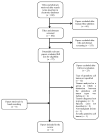Adult Granulosa Cell Tumor in Pregnancy: A New Case and a Review of the Literature
- PMID: 34828500
- PMCID: PMC8622987
- DOI: 10.3390/healthcare9111455
Adult Granulosa Cell Tumor in Pregnancy: A New Case and a Review of the Literature
Abstract
Granulosa cell tumors are rare ovarian tumors that can arise during pregnancy. We present a new case of recurrent adult granulosa cell tumor (AGCT) in pregnancy and a systematic review of the literature. The new case described is a 41-year-old woman G5P1122 with a prior history of AGCT that was referred to our center at 29 weeks because of a symptomatic abdominal mass, compatible with a possible recurrence of AGCT. At 36 + 3 weeks, she underwent a cesarean delivery for preterm labor and a total hysterectomy with a radical surgical staging. A healthy female infant was delivered. The patient received a platinum-based chemotherapy, with a 26-month follow-up negative for recurrence. Analyzing our case with the four identified by the literature review, three were recurrent and two were primary AGCT. Only one required surgery for AGCT at 15 weeks, while another underwent chemotherapy in pregnancy. In the other three cases, surgery for AGCT was done at the time of cesarean delivery. There were three cases of preterm delivery. All five pregnancies resulted in the birth of live babies with weight adequate for gestational age. In conclusion, AGCT diagnosed in pregnancy is rare, reported in only five cases. All gave birth to live babies in the third trimester, and maternal outcome at up to 18 months showed no recurrence.
Keywords: fetal outcome; granulosa cell tumor; gynecology; maternal outcome; ovarian cancer; pregnancy; recurrence.
Conflict of interest statement
The authors declare no conflict of interest.
Figures



References
Publication types
LinkOut - more resources
Full Text Sources

